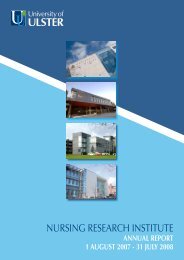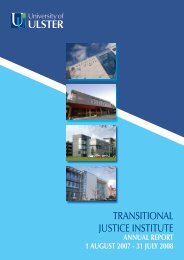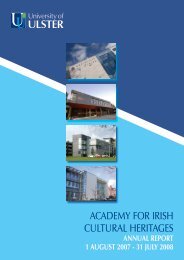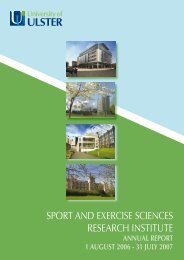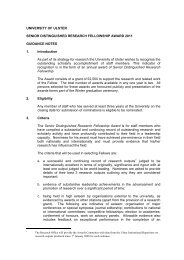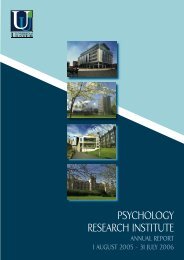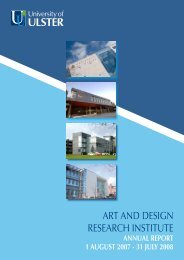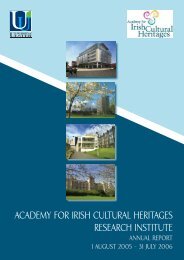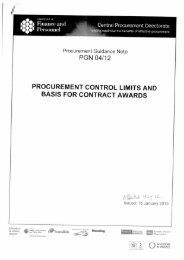environmental sciences research institute - University of Ulster
environmental sciences research institute - University of Ulster
environmental sciences research institute - University of Ulster
Create successful ePaper yourself
Turn your PDF publications into a flip-book with our unique Google optimized e-Paper software.
The effects <strong>of</strong> transboundary air pollution<br />
The deposition <strong>of</strong> chemicals from the atmosphere on to the surface <strong>of</strong> the earth is less obvious than the emission <strong>of</strong><br />
chemicals in waste water, solid waste or as a result <strong>of</strong> accidents. We can see emissions from chimney stacks in power<br />
stations and smelters and from the spraying <strong>of</strong> agrochemicals but the chemicals are deposited onto land and water many<br />
tens to hundreds <strong>of</strong> kilometres away and this is less noticeable. When these emissions cross national boundaries, this is<br />
called transboundary air pollution and the chemicals involved are carbon, sulphur, nitrogen, heavy metals and persistent<br />
organic pollutants (POPs).<br />
The heavy metals that are subject to transboundary air pollution are mercury, cadmium, lead, arsenic and zinc and the<br />
groups <strong>of</strong> POPs are the organochlorine pesticides (OCs), polychlorinated biphyenyls (PCBs) and polycyclic aromatic<br />
hydrocarbons (PAHs) and because emissions in one country can affect the quality <strong>of</strong> the environment in another these<br />
chemicals are regulated by international treaty. The United Nations Economic Commission for Europe has five such<br />
treaties and the Convention on Long-range Transboundary Air Pollution is the main way that emissions and effects <strong>of</strong><br />
transboundary air pollutants are managed; the 1998 Protocol on Heavy Metals and 1998 Protocol on Persistent Organic<br />
Pollutants (POPs) are concerned with heavy metals and POPs.<br />
The Department for the Environment and Rural Affairs (DEFRA) is responsible for implementing the Convention on<br />
Long-range Transboundary Air Pollution in the United Kingdom and they funded an investigation into the risks to lakes<br />
from heavy metals and POPs deposited from the atmosphere. As most <strong>of</strong> these pollutants are concentrated in lake<br />
sediments, they were the focus <strong>of</strong> the investigation. The work was published in 2007 (Rippey et al. 2007). The PhD<br />
<strong>of</strong> Sarah Travers increased the reliability <strong>of</strong> the assessment, by doubling the number <strong>of</strong> lakes involved, and providing<br />
independent evidence on the relevance <strong>of</strong> one <strong>of</strong> the toxicity tests used.<br />
The Tier I risk assessment was completed as follows. Eighteen lakes that covered the range <strong>of</strong> contamination by heavy<br />
metals and POPs deposited from the atmosphere in the United Kingdom and Ireland were selected (Fig. 1, previous page)<br />
and samples <strong>of</strong> the sediment retrieved. The concentrations <strong>of</strong> seven heavy metals and three groups <strong>of</strong> POPs, OCs, PCBs<br />
and PAHs, were determined and three sediment toxicity tests completed. The toxicity tests were reproduction and<br />
survival with Daphnia magna, growth and emergence with Chironomus riparius and growth and survival with Gammarus<br />
pulex (Fig. 2). The first two species are well established in sediment toxicity tests, but the latter much less so. Although<br />
there was evidence that Gammarus should be particularly sensitive to heavy metals, Sarah showed that this is not the<br />
case and that the Chironomus riparius test is the most relevant and efficient way <strong>of</strong> establishing sediment toxicity.<br />
Figure 2. Sediment<br />
toxicity tests.<br />
<br />
14



